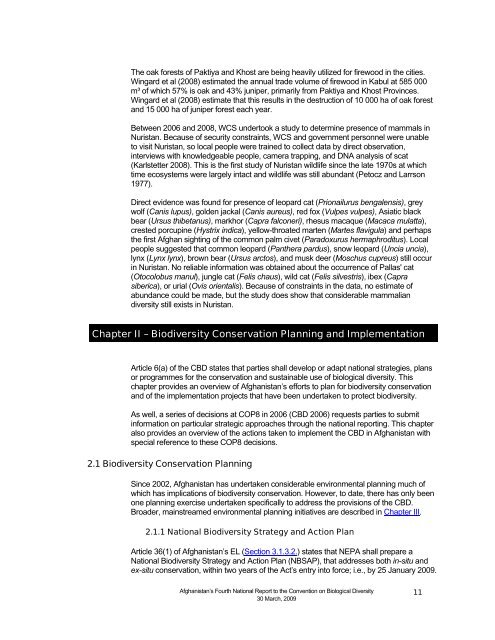Afghanistan's Fourth National Report to the Convention on ...
Afghanistan's Fourth National Report to the Convention on ...
Afghanistan's Fourth National Report to the Convention on ...
Create successful ePaper yourself
Turn your PDF publications into a flip-book with our unique Google optimized e-Paper software.
The oak forests of Paktiya and Khost are being heavily utilized for firewood in <str<strong>on</strong>g>the</str<strong>on</strong>g> cities.Wingard et al (2008) estimated <str<strong>on</strong>g>the</str<strong>on</strong>g> annual trade volume of firewood in Kabul at 585 000m³ of which 57% is oak and 43% juniper, primarily from Paktiya and Khost Provinces.Wingard et al (2008) estimate that this results in <str<strong>on</strong>g>the</str<strong>on</strong>g> destructi<strong>on</strong> of 10 000 ha of oak forestand 15 000 ha of juniper forest each year.Between 2006 and 2008, WCS under<str<strong>on</strong>g>to</str<strong>on</strong>g>ok a study <str<strong>on</strong>g>to</str<strong>on</strong>g> determine presence of mammals inNuristan. Because of security c<strong>on</strong>straints, WCS and government pers<strong>on</strong>nel were unable<str<strong>on</strong>g>to</str<strong>on</strong>g> visit Nuristan, so local people were trained <str<strong>on</strong>g>to</str<strong>on</strong>g> collect data by direct observati<strong>on</strong>,interviews with knowledgeable people, camera trapping, and DNA analysis of scat(Karlstetter 2008). This is <str<strong>on</strong>g>the</str<strong>on</strong>g> first study of Nuristan wildlife since <str<strong>on</strong>g>the</str<strong>on</strong>g> late 1970s at whichtime ecosystems were largely intact and wildlife was still abundant (Pe<str<strong>on</strong>g>to</str<strong>on</strong>g>cz and Larrs<strong>on</strong>1977).Direct evidence was found for presence of leopard cat (Pri<strong>on</strong>ailurus bengalensis), greywolf (Canis lupus), golden jackal (Canis aureus), red fox (Vulpes vulpes), Asiatic blackbear (Ursus thibetanus), markhor (Capra falc<strong>on</strong>eri), rhesus macaque (Macaca mulatta),crested porcupine (Hystrix indica), yellow-throated marten (Martes flavigula) and perhaps<str<strong>on</strong>g>the</str<strong>on</strong>g> first Afghan sighting of <str<strong>on</strong>g>the</str<strong>on</strong>g> comm<strong>on</strong> palm civet (Paradoxurus hermaphroditus). Localpeople suggested that comm<strong>on</strong> leopard (Pan<str<strong>on</strong>g>the</str<strong>on</strong>g>ra pardus), snow leopard (Uncia uncia),lynx (Lynx lynx), brown bear (Ursus arc<str<strong>on</strong>g>to</str<strong>on</strong>g>s), and musk deer (Moschus cupreus) still occurin Nuristan. No reliable informati<strong>on</strong> was obtained about <str<strong>on</strong>g>the</str<strong>on</strong>g> occurrence of Pallas' cat(O<str<strong>on</strong>g>to</str<strong>on</strong>g>colobus manul), jungle cat (Felis chaus), wild cat (Felis silvestris), ibex (Caprasiberica), or urial (Ovis orientalis). Because of c<strong>on</strong>straints in <str<strong>on</strong>g>the</str<strong>on</strong>g> data, no estimate ofabundance could be made, but <str<strong>on</strong>g>the</str<strong>on</strong>g> study does show that c<strong>on</strong>siderable mammaliandiversity still exists in Nuristan.Chapter II – Biodiversity C<strong>on</strong>servati<strong>on</strong> Planning and Implementati<strong>on</strong>Article 6(a) of <str<strong>on</strong>g>the</str<strong>on</strong>g> CBD states that parties shall develop or adapt nati<strong>on</strong>al strategies, plansor programmes for <str<strong>on</strong>g>the</str<strong>on</strong>g> c<strong>on</strong>servati<strong>on</strong> and sustainable use of biological diversity. Thischapter provides an overview of Afghanistan’s efforts <str<strong>on</strong>g>to</str<strong>on</strong>g> plan for biodiversity c<strong>on</strong>servati<strong>on</strong>and of <str<strong>on</strong>g>the</str<strong>on</strong>g> implementati<strong>on</strong> projects that have been undertaken <str<strong>on</strong>g>to</str<strong>on</strong>g> protect biodiversity.As well, a series of decisi<strong>on</strong>s at COP8 in 2006 (CBD 2006) requests parties <str<strong>on</strong>g>to</str<strong>on</strong>g> submitinformati<strong>on</strong> <strong>on</strong> particular strategic approaches through <str<strong>on</strong>g>the</str<strong>on</strong>g> nati<strong>on</strong>al reporting. This chapteralso provides an overview of <str<strong>on</strong>g>the</str<strong>on</strong>g> acti<strong>on</strong>s taken <str<strong>on</strong>g>to</str<strong>on</strong>g> implement <str<strong>on</strong>g>the</str<strong>on</strong>g> CBD in Afghanistan withspecial reference <str<strong>on</strong>g>to</str<strong>on</strong>g> <str<strong>on</strong>g>the</str<strong>on</strong>g>se COP8 decisi<strong>on</strong>s.2.1 Biodiversity C<strong>on</strong>servati<strong>on</strong> PlanningSince 2002, Afghanistan has undertaken c<strong>on</strong>siderable envir<strong>on</strong>mental planning much ofwhich has implicati<strong>on</strong>s of biodiversity c<strong>on</strong>servati<strong>on</strong>. However, <str<strong>on</strong>g>to</str<strong>on</strong>g> date, <str<strong>on</strong>g>the</str<strong>on</strong>g>re has <strong>on</strong>ly been<strong>on</strong>e planning exercise undertaken specifically <str<strong>on</strong>g>to</str<strong>on</strong>g> address <str<strong>on</strong>g>the</str<strong>on</strong>g> provisi<strong>on</strong>s of <str<strong>on</strong>g>the</str<strong>on</strong>g> CBD.Broader, mainstreamed envir<strong>on</strong>mental planning initiatives are described in Chapter III.2.1.1 <str<strong>on</strong>g>Nati<strong>on</strong>al</str<strong>on</strong>g> Biodiversity Strategy and Acti<strong>on</strong> PlanArticle 36(1) of Afghanistan’s EL (Secti<strong>on</strong> 3.1.3.2.) states that NEPA shall prepare a<str<strong>on</strong>g>Nati<strong>on</strong>al</str<strong>on</strong>g> Biodiversity Strategy and Acti<strong>on</strong> Plan (NBSAP), that addresses both in-situ andex-situ c<strong>on</strong>servati<strong>on</strong>, within two years of <str<strong>on</strong>g>the</str<strong>on</strong>g> Act’s entry in<str<strong>on</strong>g>to</str<strong>on</strong>g> force; i.e., by 25 January 2009.Afghanistan’s <str<strong>on</strong>g>Fourth</str<strong>on</strong>g> <str<strong>on</strong>g>Nati<strong>on</strong>al</str<strong>on</strong>g> <str<strong>on</strong>g>Report</str<strong>on</strong>g> <str<strong>on</strong>g>to</str<strong>on</strong>g> <str<strong>on</strong>g>the</str<strong>on</strong>g> <str<strong>on</strong>g>C<strong>on</strong>venti<strong>on</strong></str<strong>on</strong>g> <strong>on</strong> Biological Diversity30 March, 200911
















